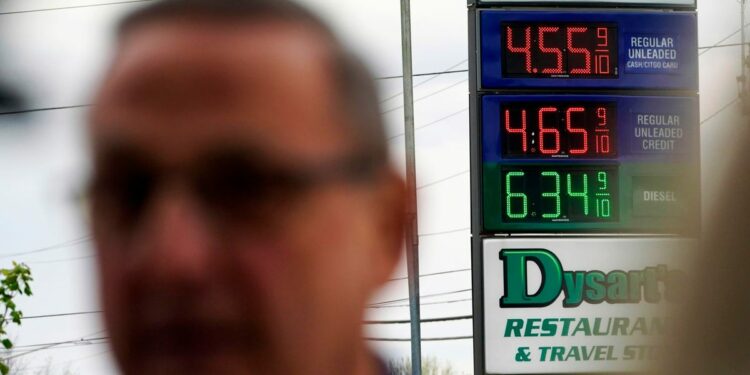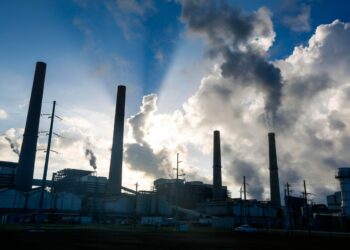Get ready for gasoline prices to surpass $5 a gallon across the U.S. soon – and $6 gas is not out of the question by the end of this summer.
The price of regular unleaded gasoline has already surpassed $5 a gallon in 10 states and the District of Columbia. Consumers in California are now dealing with $6 gas when they pull up to the pump.
It’s hard to say how bad the price pain could get as the “summer driving season” – when fuel demand peaks – kicks off this Memorial Day weekend.
But it will surely be a cruel summer.
That’s because the situation in domestic fuel markets is downright dire. Lacking the production capacity to meet rising demand, U.S. refiners are playing “Whack-A-Mole” to address the market’s most pressing need, shifting plants to focus on gasoline and diesel output.
The move amounts to triage in today’s grossly under-supplied market. To say that gasoline, diesel and jet fuel are in short supply heading into the summer heavy travel season would be an understatement.
Total U.S. gasoline inventories of around 220 million barrels are about 8 percent below the five-year average for this time of year, with East Coast stockpiles at their lowest level since 2011. Meanwhile, crude oil prices show no signs of dropping below $100 a barrel due to their supply constraints in “upstream” production, including the loss of significant Russian volumes.
The situation with diesel is even worse. U.S. diesel inventories are at their lowest level for May since 2000, and East Coast stocks recently hit their lowest mark for any week or month since the U.S. Energy Information Administration (EIA) started tracking them in 1990. Retail diesel prices are around $5.70 a gallon, which are already 75 percent higher than a year ago.
Refining profit margins, also known as crack spreads, for diesel — and, more recently, gasoline — have gone parabolic, giving refiners the strongest financial signal ever to produce more diesel and gasoline as we enter the summer travel season. More jet fuel too.
The problem is that U.S. refineries are already running flat-out. And the longer they run at full output, the greater the need for maintenance, which requires refineries to shut down temporarily.
What about Europe? The EU is facing big cuts in crude oil and refined products imports from Russia as well as much higher prices for — and possible shortages of — oil and natural gas, the latter being the primary fuel for operating refinery hydrocrackers, which upgrade low-quality heavy gas-oils into high-quality diesel, gasoline, and jet fuel.
The whole fuel supply chain is a mess and not easily fixable.
The United States and other big consumer nations have already tapped their strategic petroleum reserves at unprecedented levels. The Biden administration has also loosened rules to allow summertime sales of gasoline with higher ethanol content despite that moves’ adverse environmental effects. The White House is also considering a release of diesel fuel from federal reserves to address skyrocketing prices and the threat of supply outages on the East Coast.
Such moves are only Band-Aids, though.
Global markets lost roughly 4 million barrels a day of refining capacity during the pandemic, including nearly 1 million barrels a day in the United States alone. Refiners’ decision to reduce production capacity early in the pandemic was a response to the drop in demand and political signals from the push to transition to low-carbon energy.
Refiners can’t keep up now that fuel demand is rising back to pre-pandemic rates. The situation will only get worse once the demand for jet fuel rebounds.
Looming on the horizon is also the gradual reopening of the Chinese economy after widespread Covid lockdowns. That will boost fuel demand while Europe is trying to formalize its ban on Russian energy imports – a move that will put exports from Russia, a major diesel and fuel oil exporter, in jeopardy.
There is also the Atlantic hurricane season to consider. Recent hurricane seasons, which run from June 1 to November 30, have seen major storms take out significant capacity in the U.S. Gulf Coast, the heart of America’s refining belt.
It’s no wonder that JP Morgan analysts see $6 gasoline by the end of August as a reality. The bank thinks U.S. gasoline inventories could drop to 160 million barrels by Labor Day – the lowest level since 1950.
Nor does it look like reduced consumption will save the day. After two years of pandemic restrictions, Americans are ready to roll and show no signs – at least so far – that high prices will hold them back from travel.
In the coming days and weeks, the Biden administration will undoubtedly be tempted to ban U.S. refiners from exporting fuel to Latin America and Europe. The White House insists that all options are on the table as Democrats fear an energy price backlash at the polls this November in midterm elections.
But this move would stomp on free-market principles and ignore the real problem: the world is short on refining capacity, and that petroleum commodity prices are set in a global marketplace.











